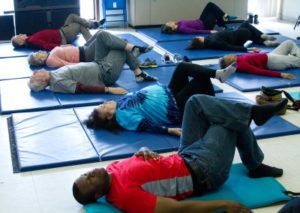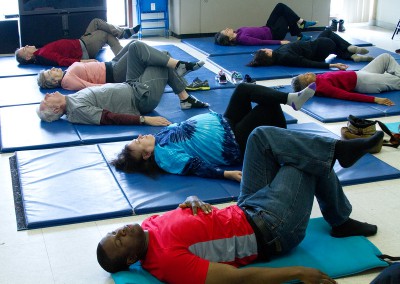On Saturday, March 21, 2015, just over a dozen instructors from the Washington DC area introduced over 100 members of the public to the Feldenkrais Method. In group classes (called Awareness Through Movement or ATM) and individual hands-on sessions (known as Functional Integration), participants were offered the opportunity to slow down and listen to themselves in order to unmask the untapped potential of their nervous systems, the possibilities that are usually hidden from us by our habits.
The 3rd DC Feldenkrais Festival was truly a community affair, and we heard a lot of positive feedback from participants afterwards. As we look ahead towards a likely 4th Festival some time this summer, here are some sights and sounds from the first day of spring:

photo: Yulia Kriskovets
Led by Chrish Kresge, students discover how the weight of the arm gets lighter when its movement is connected to the sliding of the shoulder blade, the rotation of the spine and the direction of gaze of the eyes.

photo: Yulia Kriskovets
“Now place your hand on your forehead and use it guide your face in the direction of the ceiling. The arm does the work. The muscles in your neck do not have to make any effort.”
Joni Eisenberg (in the tie-dye shirt, below), helped spread the word about the Festival to a broader audience when she invited Donna Blank and Seth Dellinger to discuss the Feldenkrais Method on her WPFW radio show, To Heal DC. Note to music fans: the show also included some terrific tracks from Sun Ra, Alice Coltrane, Anthony Braxton and Cab Calloway!
(You can hear Joni’s show every Monday morning at 10am EST.)

photo: Seth Dellinger
By crossing one leg over the other and tilting the legs together to the side, we can gently and easily lengthen the entire spine. By paying attention not to hold the breath and noticing how all the different parts of the skeleton can be carried along by the weight of the legs, we can learn to let go of habitual unnecessary muscular contractions. This class was led by Yulia Kriskovets (below).
photo: Chrish Kresge
Adrienne Penebre (below) specializes in working with children with special needs. Here she leads a group of adults through a series of rolling movements that take them back to their first year of life.

photo: Chrish Kresge
photo: Yulia Kriskovets
Sometimes, in order to improve our adult posture, it’s helpful to roll like a baby!
photo: Yulia Kriskovets
By revisiting our earliest developmental stages, we have the opportunity to strengthen the learning that is the foundation for every other skill we have learned since.
photo: Yulia Kriskovets
Awareness Through Movement is not only performed on the floor. Many lessons are offered in chairs for those who may have difficulty getting down to the ground, such as this exploration of side bending led by Derick Carter (above). Other lessons explore the transition between different orientations such as lying, sitting or standing. There are also lessons that improve the organization of the entire self by exploring specific functions such as crawling, walking, hopping, reaching . . . or even standing on your head!
photo: Seth Dellinger
Terence McPartland (above), Feldenkrais practitioner and a leader of the DC Judo Association, guides participants to a new understanding of balance. During the lesson, students did movements with the soles of the feet resting on small foam rollers to experience the challenge of finding stability on an unstable surface. This exploration helps remind our feet of the flexibility that was a normal feature of our species before we wore shoes or walked on flat sidewalks.
During lunch, Feldenkrais trainer Donna Blank, who has done this work for over three decades, recounted some of her experiences of studying with Moshe Feldenkrais at Amherst College in the early 1980s.
“There were over 200 of us there. . . There are literally countless stories of people who changed their lives because they didn’t know what they were getting into – in terms of the profound effects it would have on their whole self image and their sense of possibility . . . There were people there who were artists, who were doctors, who were farriers, social workers . . . so many different disciplines . . . some people came because they were in a lot of pain and they wanted it for their own healing.”
“He started with the body, and he started also with the notion of discovery. If you took lessons this morning, you would realize . . . we would do these funny little things. . . and by the end you would experience changes through your whole self, but you didn’t know how you were going to get there. And there’s a good reason for that: most of us, when we decide that we’re going to do something with an intention, we mobilize the patterns that are already built into us in order to do the thing we want to do…”
“He was very interested in our habits and our self-image – that is related to our habits – and how . . . our sense of self can change as we begin to discover what are habits are, and what the possibilities are beyond what we normally do.”
“He was very interested in the kind of awareness that comes when we step back from our habitual response and can find new possibilities. That was his core interest.”

photo: Yulia Kriskovets
Following the discussion, Donna guided participants through an exploration of reaching with the arms on the backs, the sides and in standing in order to “gently bring our parts into the whole of reaching out from a grounded place.”
photo: Chrish Kresge
At the beginning of an Awareness Through Movement lesson, students are often asked to simply lie on their backs and pay attention to the dynamic relationship between their body and the floor. They return to this self-observation again and again as the lesson progresses, noticing how different movement explorations change the state of the musculature in different places. In this lesson, led by Seth Dellinger (above), students were asked to consider the possibility that the rhythm of breathing would affect not only the shape of their chest with each inhalation and exhalation, but could create a sensation of the whole self pulsing against the floor. By the end of the hour of expanding the ribs in a dozen different ways, this image made more sense to some.

photo: Chrish Kresge
photo: Chrish Kresge
“Now interlace your fingers and bring them in front of your face. Notice which thumb is on top. Now interlace your fingers again with the other thumb on top. How does that feel? Kind of weird, right? But the funny thing is, that might be the way your neighbor did it the first time. This is a habit you might not have known you had!”
– – – – – – – – – – – – – – – – – – – – – – – – –
In addition to the 8 Awareness Through Movement classes offered at the Festival, over 30 participants had the opportunity to experience a session of Functional Integration. In this format, the practitioner connects with her student through the medium of touch, listening to how he responds, and offering gentle guidance towards new possibilities . . .

photo: Seth Dellinger
Above, foreground: Jutta Brettschneider, Below: Arona Primalani
photo: Yulia Kriskovets
Feldenkrais often described Functional Integration as a kind of a dance between two nervous systems. In his book, The Case of Nora, Feldenkrais described how these two systems could become unified to form “a new ensemble . . . a new entity. . . Both the touched and the toucher feel what they sense through the connecting hands, even if they do not understand and do not know what is being done. The touched person becomes aware of what the touching person feels and, without understanding, alters his configuration to conform to what he senses is wanted from him. When touching I seek nothing from the person I touch; I only feel what the touched person needs . . . whether he knows it or not, and what I can do at that moment to make the person feel better.”

photo: Yulia Kriskovets
Above: Jane Johnston, Below: Carol Regan
photo: Seth Dellinger
photo: Yulia Kriskovets
Above: Heidi Menocal, Below: Derick Carter
photo: Yulia Kriskovets
Here are a few comments we received following the Festival:
“I really noticed a difference, even now, three days later. I like the meditative style . . . Thanks for giving this to the community — it was great!”
“Great Experience. Having sessions with four different instructors in one day helped me vary and intensify my practice. Thanks for the experience and for your time and effort in making the Festival happen.”
“Thank you for a wonderful event. It was a very positive and encouraging experience. I’d like to stick with it and try a new class and do FI. Thank you all for the wonderful welcome, for providing this opportunity and for being there with these resources for us to follow up on.”
“Thank you for organizing such an awesome event. It was an amazing, rare and very interesting opportunity to experience variety of classes with different instructors. I knew ATM was fascinating and fun, I love it even better now. Looking forward for the next one!”
So are we!
It seems that slowing down every once in a while isn’t such a bad thing after all. And, as it turns out, when you stand up at the end, you might just feel taller, lighter, and more ready for whatever life has in store for you next!
photo: Yulia Kriskovets
Were you at the 3rd DC Feldenkrais Festival? Please use the comments box to share your experience!













Really a very mixed crowd of ages, abilities and interests. It truly speaks to the versatility of the method! Thanks Seth for organizing a great event for us!